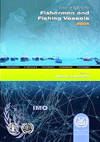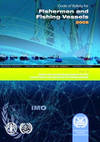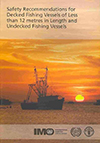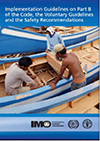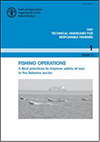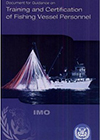Guidelines and Codes
FAO, IMO and ILO, developed several instruments, voluntary in nature, to promote safety of fishing vessels and fishers. Some of the main instruments are summarized in this page.
Code of Safety for Fishermen and Fishing Vessels, 2005
The Code of Safety is a two-part guidebook recommending “safety and health practices for fishermen (Part A)” and “safety and health requirements for the construction and equipment of fishing vessels (Part B)”.
Part A provides details on the duties and responsibilities of competent authorities, skippers and crew, information on fishers’ education, training and safety awareness, and on health and medical care in the fishing industry. It applies to fishing vessels of all sizes and includes a dedicated section for undecked vessels and decked vessels of less than 12 metres in length. Part B provides information to shipbuilders and owners on the design, construction and equipment of fishing vessels, with a view to promoting the safety of fishing vessels as well as the safety and health of the crew. Part B applies only to fishing vessels of 24 metres in length and over.
The Code of Safety can serve as a useful guide to those concerned with developing national laws and regulations on the safety of fishing vessels and fishers.
Voluntary Guidelines for the Design, Construction and Equipment of Small Fishing Vessels, 2005
The purpose of these Guidelines is to provide general guidance on safe practices for the design, construction, and equipment of decked fishing vessels between 12 and 24 m in length. The Guidelines include sections on construction, stability, machinery, fire protection, protection of crew, lifesaving appliances, emergency procedures, radio communications, navigational equipment and crew accommodation.
Safety Recommendations for Decked Fishing Vessels of Less than 12 metres in Length and Undecked Fishing Vessels, 2012
These recommendations provide information on the design, construction, equipment, training and protection of the crews of small fishing vessels with a view to promoting the safety of the vessel and the safety and health of the crews. The provisions apply to decked vessels of less than 12 metres in length and undecked vessels intended to operate at sea, as well as on oceans, rivers, lakes and dams, or on any body of water. Aspects covered in these practical recommendations are: vessel construction, stability and seaworthiness, machinery and electrical installations, fire protection and firefighting, protection of crew, life-saving appliances, emergency procedures and safety training, radio communications, navigational equipment, crew accommodation, and manning, training and competence development. These recommendations have also been translated by SEAFDEC into several Asian languages.
Implementation Guidelines on Part B of the Code, the Voluntary Guidelines and the Safety Recommendations, 2014
These Guidelines aim to assist maritime, labour and fisheries ministries (and any other relevant government ministry) in the implementation of the three FAO/ILO/IMO instruments on the design, construction and equipment of fishing vessels of all types and sizes. The Guidelines cover legal, administrative, strategic and operational requirements of safety, capacity building, training of crew members, and enforcement of regulations. The Guidelines provide basic information to increase understanding of the technical provisions and terminology of the instruments, show where to find information in the IMO/ILO/FAO instruments and provide useful examples.
Technical Guidelines for Responsible Fisheries: Fishing operations: Best Practices to improve safety at sea in the fisheries sector, 2015
These Technical Guidelines support authorities to develop and implement strategies to improve safety, health and working conditions in fisheries operations. The Guidelines cover the following subjects: Data and information collection and analysis to improve safety, national fisheries sector inventories (baseline surveys —with a focus on human resources— to understand causes of accidents at sea), problems, solutions and safety strategy development, and gives advice on how to manage change.
FAO/ILO/IMO Document for guidance on training and certification of fishing vessel personnel (2001)
This guidance document provides information for administrations and educational and training institutions on the organization of training of fishing vessel personnel, as well as the subjects to be covered, training methods to use and certification requirements.

